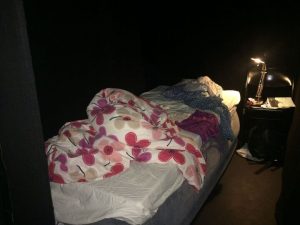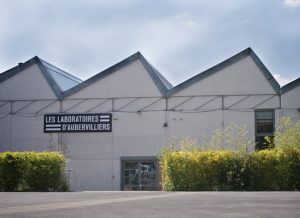 All photos courtesy of The Ark: Center for Experimentation Grace Ndiritu Laboratories d’Aubervilliers, Paris
All photos courtesy of The Ark: Center for Experimentation Grace Ndiritu Laboratories d’Aubervilliers, Paris
It was a strange feeling walking into The Ark for my first cooking duty before the other participants arrived. I had had a busy day in Paris, gadding about and generally enjoying the urban buzz. How would I cope with being in Paris, but not in Paris? The Ark took place in experimental arts centre Les Laboratoires d’Aubervilliers, my home for the next 8 days. Aubervilliers is a traditional, industrial, working class commune, with a high proportion of African inhabitants. Coming out of the metro Aubervilliers-Pantin-Quatre-Chemins, you’ll see people sleeping rough, cheap ethnic shops, lots of graffiti. It feels edgy, urban, and very familiar. As I entered the Labos premises I gave in my phone, camera, passport and money and mentally committed myself to the experience. And what an experience it was! The Ark was the brainchild of visionary artist Grace Ndiritu and, apart from myself, there were fourteen other participants from all over the world – Slovenia, Japan, Russia, Panama, France and the US.
There’s a website in progress about the whole experience which might be of interest:
http://thearkcenterexperiment.com/THE-ARK
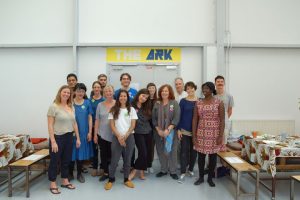
Our aims were to create a sustainable community, similar to Biosphere 2. Built 25 years ago in the Arizona desert, Biosphere 2 was originally meant to demonstrate the viability of closed ecological systems to support and maintain human life in outer space, it lasted for one mission only as the eight scientists who lived there for two years experienced considerable difficulties. The Ark referenced this project but in an artistic, creative and playful sense – exploring what it meant to be part of a community of likeminded people who are concerned about the planet and its future, or lack of it. What does it mean to be living in the Anthropocene era, the period when we look back at humanity’s impact on the Earth and comprehend that we are the generation who has the most awareness of this impact. How does it affect us physically and spiritually? Everything about the week was geared towards this consciousness raising.
Here’s the Ark’s mission statement:
The Ark is a post-internet living research/live art project on an epic scale. Part – scientific experiment and part – spiritual experience and is inspired by Ndiritu’s own experiences during the last decade, living on and off in New Age communities. It focuses primarily on Plants, Biology, Shamanism, Meditation, Food, Philosophy, Communities, Education, Architecture, Future of Cities, Democracy and Activism.
Each morning we had a meditation session and spiritual exercises after a silent breakfast. These were led by Rebecca Farr whose warmth and generosity enveloped us all. She was a giant security blanket in human form!
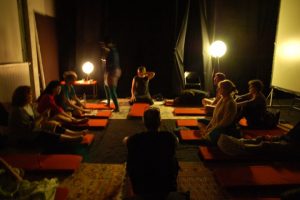
The sessions followed the ayurvedic chakra system, which is very in touch with humanity’s connection with nature. In the kitchen I worked with chef Denise Palma Ferrante, who had designed an incredible menu. If any of you have been on retreats or courses before you will know what to expect from the food – quite ordinary, carbohydrate heavy and, if you are a vegetarian, fairly predictable. This was its polar opposite – Denise had devised a vegan/vegetarian/raw food/macrobiotic menu featuring cuisine from all over the world – Korea, Japan, North Africa, Mexico, India… It too, followed the chakra system but worked down the body instead of upwards. My fellow sous-chefs were Maxime, an artist, and Julian, a radical gardener.
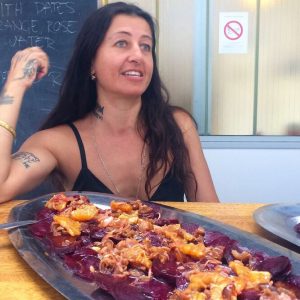

Meat and fish were introduced once The Ark went public and we came out of our bubble and it was at this point I discovered I was, surprisingly, the only vegetarian. According to organisations such as the European Health Parliament, the World Health Organisation, Oxford University research scientists and organisations concerned with climate change such as Climate Central, eating as little meat and fish as possible, if at all, will really help the planet to support a human population for longer. Replenishing the ocean and using the land to grow crops for direct human consumption would reduce global hunger and water usage. It takes 2,464 gallons of water to produce one pound of beef. This is the equivalent of taking a seven minute shower every day for six months. It takes 25 gallons of water to produce one pound of wheat. It might also make us kinder, Ghandi said, ‘The greatness of a nation and its moral progress can be judged by the way its animals are treated.’
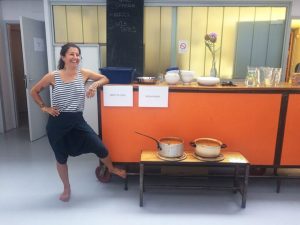
I spent most of my free time curled up with my writing pad, exploring ideas and experiences poetically, always my way of processing the world. My favourite place to do this was the garden, an inspiring and imaginative urban space with herbs, vegetables and flowers. 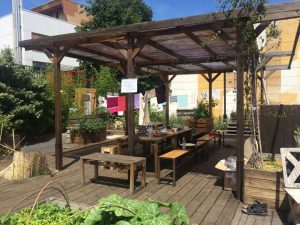 Particularly striking were the giant cardooms and the whole space was enhanced by the presence of Josette and Margeurite, the resident hens. The yard gates were the limit of our world and as we socialised in the garden in the evenings we could hear dance music from the theatre next door. There was also quite a famous boxing club there and we watched the comings and goings from afar.
Particularly striking were the giant cardooms and the whole space was enhanced by the presence of Josette and Margeurite, the resident hens. The yard gates were the limit of our world and as we socialised in the garden in the evenings we could hear dance music from the theatre next door. There was also quite a famous boxing club there and we watched the comings and goings from afar.
Every day there were talks by academics who were part of the community. A very positive aspect of The Ark was that whatever our role outside, inside The Ark we worked together, both in and out of our comfort zones. We had talks on the biosphere, women’s co-operatives, Amazonian agricultural systems, identity, art, gender and the Anthropocene and the structure of cults.
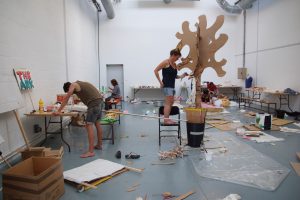 In the afternoons we made masks and costumes, led by talented artists Urara Tsuchiya and Anna Tanner. This was for the grand finale of The Ark project– a street carnival parade of extinct animals, reverse Darwinism in action. I was on megaphone duty shouting slogans in French and English through the bemused but entertained streets of Aubervilliers, resplendent in tie-dye and blue face paint!
In the afternoons we made masks and costumes, led by talented artists Urara Tsuchiya and Anna Tanner. This was for the grand finale of The Ark project– a street carnival parade of extinct animals, reverse Darwinism in action. I was on megaphone duty shouting slogans in French and English through the bemused but entertained streets of Aubervilliers, resplendent in tie-dye and blue face paint!
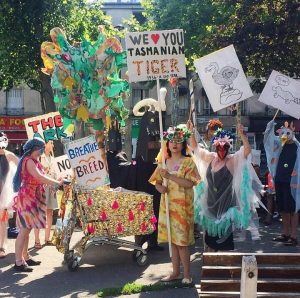
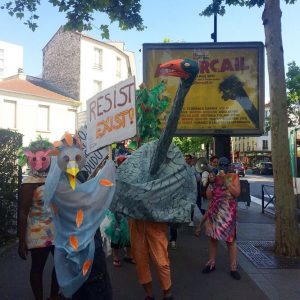
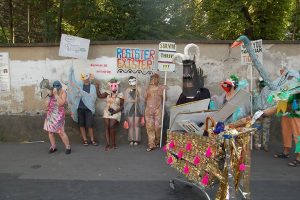
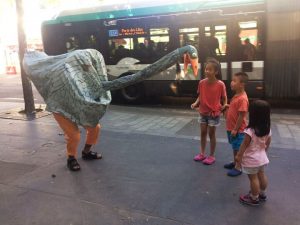
During The Ark I led a food poetry workshop. The exercises I chose were designed to echo our experiences and the first entailed writing haiku. This Japanese poetry form’s minimalist, zen-like, focused style paralleled our spiritual practice. Haiku traditionally focus on a contemplation of nature and the seasons, very much in tune with our garden shrine and plant communication exercises. Haiku are deceptively simple, they are extraordinarily profound and can be tricky to write. The second part of the workshop celebrated the never-ending, pleasure-giving stream of amazing food which came out of Denise’s kitchen. Below is Gleb, our Russian academic, in mid-composition.

I used U A Fanthorpe’s poem “Harvest Festival” as a prompt. I was both impressed and moved by the poetry the group produced. The Ark forced us to explore our vulnerabilities and poetry is an effective tool for such exploration. Words, associations, emotions and ideas seem to bubble up from the unconscious. In the workshop I also wanted to celebrate diversity by encouraging participants to write in their own languages and to enjoy the musicality of the unknown. This led to poems in Japanese, Russian, Spanish and French.
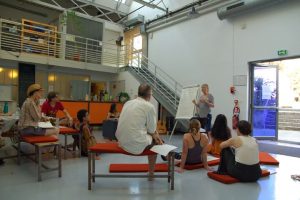
We also had a mini-cinema showing films which echoed the ethos and concerns of The Ark, such as Her, Into the Wild, La Jetee, Incendies, Solaris, Inception, Cloud Atlas, Kumare and many more – films which explore different ways of seeing the world, the future and survival. One film which kept coming to mind was The Martian, partly because Biosphere 2 was geared towards exploring how such systems could be successfully established on other planets. In some ways Biosphere 2 was revolutionary, but in others it was a disaster. Perhaps the fact that William Burroughs was one of the movers and shakers behind it should have rung a few warning bells?
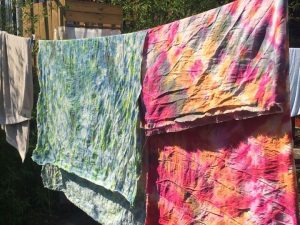 I loved the way our community developed – after no contact with the outside world it was both a wonder and a shock to communicate with the staff at the Labos after days of smiling but not talking and then to venture further afield to interact with the local community. By the end of the day we were also dancing like mad to a great selection of music, with Max and Julian DJ-ing as the street parade was followed by a public barbecue. The following day the Labos opened to the public for academic round-table discussions. The timing was perfect, who knows what would have happened if we’d been Arkees for longer, as over the week we had gone feral – enjoying the outdoor shower (it was a really hot week), spraying each other with water to cool down, gradually losing our flip-flops to go barefoot, eating with our hands Southern Indian style, wearing more and more makeshift outfits to cope with the heat (I ended up wearing the bit of cloth I’d taken as a pillowslip as a sarong for most of the week!).
I loved the way our community developed – after no contact with the outside world it was both a wonder and a shock to communicate with the staff at the Labos after days of smiling but not talking and then to venture further afield to interact with the local community. By the end of the day we were also dancing like mad to a great selection of music, with Max and Julian DJ-ing as the street parade was followed by a public barbecue. The following day the Labos opened to the public for academic round-table discussions. The timing was perfect, who knows what would have happened if we’d been Arkees for longer, as over the week we had gone feral – enjoying the outdoor shower (it was a really hot week), spraying each other with water to cool down, gradually losing our flip-flops to go barefoot, eating with our hands Southern Indian style, wearing more and more makeshift outfits to cope with the heat (I ended up wearing the bit of cloth I’d taken as a pillowslip as a sarong for most of the week!).
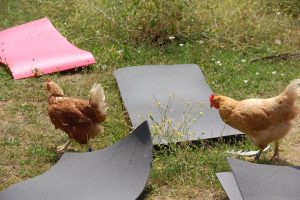
I cried, I laughed, I vented – there was a deep and eerie interconnectedness with everyone in the group and in everything we did. I re-discovered a sense of fun and creative play, took risks and made, and am still making, extraordinary discoveries. And I wrote and wrote and am still writing, including a kind of haiku journal – here are a few entries:
trees cast their doubles the scent of cedar
on the wall – a theatre set sage, tobacco and sweet grass
for shadow play thickens the still air
lavender flowers
on yoghurt – calyx and corolla
like fallen stars
The final evening, just as we had accepted that we would have to go back to reality, the heavens opened and there was an apocalypitc thunderstorm with torrential rain. Perhaps it was a sign that we should stay in The Ark if we hoped to survive?!
Since the project, I have become fascinated with the idea of Dark Ecology. Tim Morton, a philosopher, coined the term in his book Dark Ecology – A logic for future co-extistence. Its basic message is that environmental catastrophe has already happened so we need to focus our energies in different ways in an age of radical awareness and, indeed, rethink the whole idea of ecology. There’s a fascinating article below about Morton:
https://www.theguardian.com/world/2017/jun/15/timothy-morton-anthropocene-philosopher
If your appetite has been whetted and you want to explore further, check out
https://www.thevenusproject.com/
By a strange coincidence (although by now I should know there is no such thing!), my latest Poetry Book Society bundle included “Fast” by Jorie Grahame, here’s the book cover blurb:
In her first new collection in five years—her most exhilarating, personal, and formally inventive to date—Graham explores the limits of the human and the uneasy seductions of the posthuman. Conjuring an array of voices and perspectives—from bots, to a holy shroud, to the ocean floor, to a medium transmitting from beyond the grave—these poems give urgent form to the ever-increasing pace of transformation of our planet and ourselves. As it navigates cyber life, 3D-printed “life,” life after death, biologically, chemically, and electronically modified life, Fast lights up the border of our new condition as individuals and as a species on the brink.
It’s a tough, but really worthwhile and satisfying read.
I still feel I’m catching up on sleep after an extraordinarily enriching experience, which I wouldn’t have missed for the world, although I don’t miss my dorm bed!
